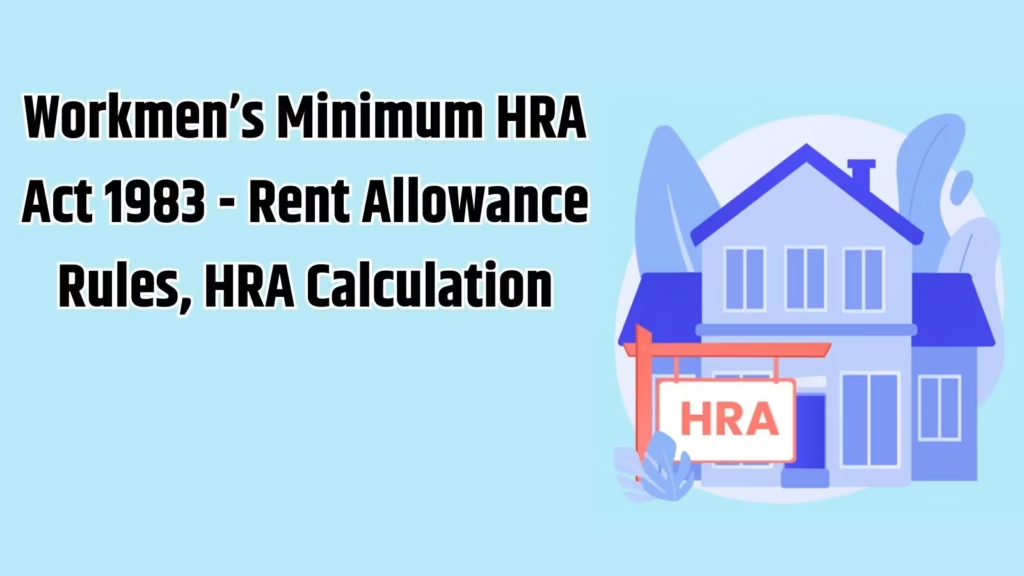Maharashtra Workmens Minimum HRA Act 1983: Hey folks, welcome back to our educational blog where we break down complex laws into bite-sized, easy-to-digest pieces. Today, we’re diving into something that’s super relevant if you’re working in Maharashtra’s industrial sector or running a business there—the Maharashtra Workmen’s Minimum House Rent Allowance Act, 1983. This law might sound a bit dusty, but it’s all about ensuring workers get a fair shot at affording decent housing. Think of it as a safety net for rent costs in a state where living expenses can add up fast. We’ll walk through what it means, who it covers, and how it works, with some handy tips along the way. Let’s get started!
Why Was Workmens Minimum HRA Act Introduced?
Back in the early 1980s, Maharashtra was booming with industries, but many workers struggled with high rents in cities like Mumbai and Pune. The government stepped in with this Act to mandate a minimum house rent allowance (HRA) for workmen. Enacted in 1983 and brought into force around 1991, its main goal is to support low-wage employees by guaranteeing a portion of their pay goes toward housing. It’s not about luxury living—it’s about basic fairness. Without this, employers might skimp on HRA, leaving workers in tough spots. Over the years, it’s helped thousands balance their budgets better, especially in urban areas where rent eats up a big chunk of income.
Who Does the Workmens Minimum HRA Act Apply To?
Not every job or business falls under this law—it’s targeted at industrial setups. Here’s the lowdown:
- Industries Covered: It applies to factories and establishments in industries where the Maharashtra government handles labor disputes (under laws like the Industrial Disputes Act, 1947, or Bombay Industrial Relations Act, 1946).
- Employee Threshold: Kicks in for places with 50 or more workmen. If your workplace has branches across the state, all employees count toward that number.
- Ongoing Application: Once it applies, it sticks—even if staff numbers drop below 50 later.
- Exceptions and Extensions: The government can extend it to smaller setups (with at least a certain number of workers) after giving notice and hearing objections. But it’s mostly for larger operations.
If you’re a workman—basically, any non-managerial employee doing manual, skilled, or clerical work—this could be for you. Managers or supervisors? Probably not.
Key Provisions: What Employers Must Do
At its core, the Act requires employers to pay a minimum HRA to help cover rent. Let’s break it down:
- Minimum Amount: Employers must pay at least 5% of the workman’s monthly wages or Rs. 20, whichever is higher. Wages here mean basic pay plus dearness allowance (DA)—no bonuses or overtime included.
- When and How It’s Paid: HRA gets added to your regular wages, ideally via bank transfer or cheque. For part-time or short months, it’s pro-rated based on days worked.
- Special Cases:
- If you’re on layoff, lockout (with pay), sick leave, or maternity leave (up to 12 weeks), you still get it.
- Got company housing? If it’s free, no HRA needed. If there’s a rent deduction from your salary, the employer adjusts so you get the difference if the deduction is less than the minimum HRA.
- Higher Rates Win: If your contract, union agreement, or court award gives more than the minimum, that takes priority—no downgrading allowed.
This setup ensures workers aren’t left high and dry, especially in pricey areas.
Calculating Your HRA:
To make this clearer, here’s a simple table with examples (assuming monthly wages include basic + DA). Note: These are illustrative—always check your payslip!
| Monthly Wages (Rs.) | 5% of Wages (Rs.) | Minimum HRA (Higher of 5% or Rs. 20) |
|---|---|---|
| 2,000 | 100 | 100 |
| 300 | 15 | 20 |
| 10,000 | 500 | 500 |
| 400 | 20 | 20 |
See how it protects lower earners? For someone on Rs. 300, that Rs. 20 could cover a basic room share.
Enforcement and What Happens If It’s Ignored
The government appoints a Controlling Authority (usually a labor officer) to oversee this. If HRA isn’t paid, workers can file a claim within one year (extendable for good reasons). The authority investigates, hears both sides, and can order payment plus interest.
Penalties for non-compliance? Employers face fines—up to Rs. 500 for first offenses, escalating for repeats. In serious cases, it could lead to imprisonment. Inspectors can check records, and appeals go to higher courts. It’s all about accountability, folks.
Benefits for Workers and Employers
For workers, this Act means extra cash for rent, reducing financial stress and improving living standards. Employers benefit too—it promotes fair practices, reduces disputes, and can boost morale. Plus, complying avoids legal headaches.
Conclusion: Workmens Minimum HRA Act 1983
The Maharashtra Workmen’s Minimum House Rent Allowance Act, 1983, is a thoughtful piece of legislation that puts workers’ housing needs front and center. In a fast-growing state like Maharashtra, it’s a reminder that laws can make everyday life fairer. If you’re affected, chat with a labor advisor or union rep for personalized advice. Stay informed, and keep building that better workplace!
FAQs: Workmens Minimum HRA Act 1983
Does this apply to IT or service jobs?
Mostly no—it’s for traditional industries like manufacturing. Check if your sector falls under the listed laws.
What if my employer pays less?
File with the Controlling Authority. Keep records of your wages and claims.
Is HRA taxable?
Under income tax rules, part of it can be exempt if you pay rent, but this Act is separate from tax laws.
Can the minimum rate change?
The government can update via notifications, but the base is still 5% or Rs. 20.
What about seasonal workers?
Pro-rated based on days, as long as the workplace qualifies.

